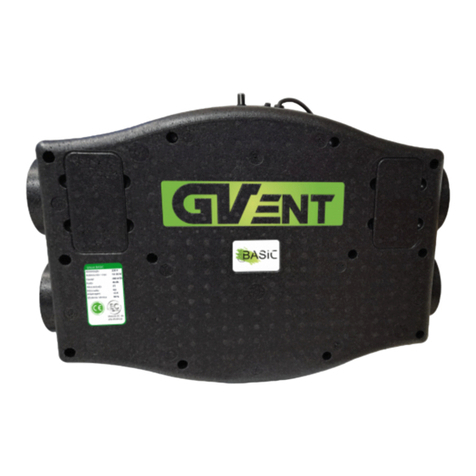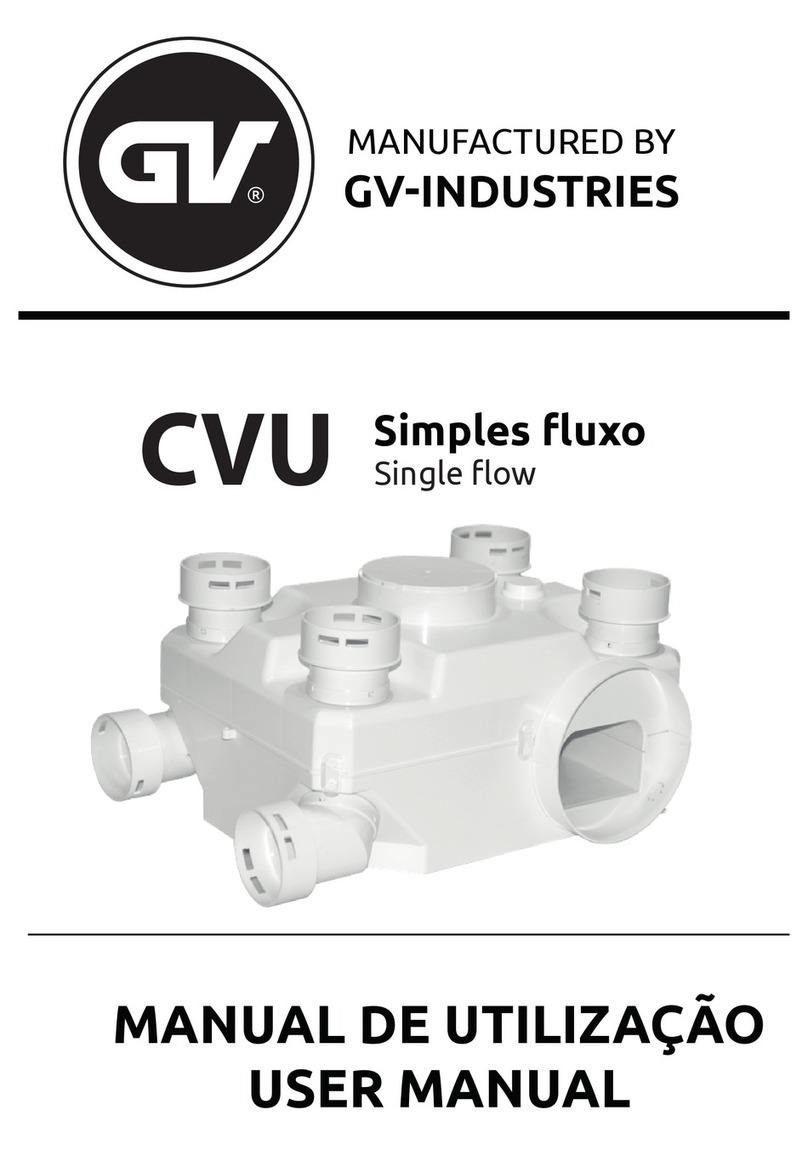
- Especificar exactamente o local, onde o dispositivo deve ser instalado.
- Preparar o cabo de alimentação de energia. Utilizar cabo elétrico 1.5mm
CUIDADO: Antes de iniciar as obras, deve certificar-se de que o cabo de alimentação não está em
tensão.
- Medir e criar uma abertura numa parede externa para a conduta telescópica do aparelho.
CUIDADO: O diâmetro da abertura deve ser pelo menos 10 mm maior em comparação com o exterior
diâmetro da conduta.
- Colocar a conduta telescópica (4) juntamente com o permutador (7) e o filtro (6) na parede externa e
selar com espuma ou algodão em lã.
A conduta deve ser montada de tal forma para que fique ligeiramente inclinada para o exterior. O
permutador juntamente com o filtro deve estar localizado a pelo menos 10 cm de distância da extremi-
dade da conduta telescópica.
- Inserir a extremidade da conduta (5) na conduta telescópica e depois fixá-la à parede com a utilização
de parafusos.
- Retirar o painel frontal do ventilador (1) e a tampa da electrónica (2).
- Arrastar o cabo eléctrico com duplo isolamento através da argola do cabo. Deslocar o cabo até que
seja possível ligá-lo a pinças de alimentação. Antes de fixar o ventilador: remover os objectos estranhos
do interior do ventilador; verificar, se o rotor gira livremente, fazendo-o mover-se com a mão.
- Insira o ventilador (3) na conduta telescópica e fixe-o à parede com o uso de parafusos.
CUIDADO: A argola do cabo deve ser colocada na parte inferior.
- Remover o isolamento externo do cabo, remover o isolamento dos fios com mais de 4 mm.
- Colocar o cabo e ligá-lo de acordo com o esquema de ligações do modelo instalado.
- Verificar se os condutores do cabo estão fortemente ligados às abraçadeiras.
- Verificar se o ventilador está fixado de forma sólida e se o sistema de cablagem eléctrica é adequado.
- Colocar e aparafusar a tampa electrónica (2).
- Verificar a vedação do cabo de ligação.
- O cabo de ligação deve ser fixado de forma a garantir que, em caso de inundação, não haja passagem
de água para as partes eléctricas.
- Montar o painel frontal (1) que constitui a protecção contra o contacto com as partes móveis.
ATENÇÃO! A hélice rotativa pode esmagar os seus dedos! É proibido ligar o ventilador
sem uma malha de protecção para as partes móveis!
A activação só pode ter lugar depois de todas as instruções de segurança terem sido verificadas e todos
os perigos terem sido eliminados. Após a activação, verificar se o ventilador funciona normalmente e de
forma adequada. Observar o trabalho do ventilador (o seu ruído, vibrações, consumo de electricidade, a
possibilidade de controlar a velocidade rotacional). O dispositivo só pode ser utilizado com o painel
frontal e a extremidade da conduta que constitui a protecção contra o contacto com as partes móveis.
O utilizador é responsável pelo cumprimento das presentes normas e pode suportar a responsabilidade
pelos acidentes resultantes da falta de elementos de protecção.
Ligação à rede eléctrica
- Apenas electricistas qualificados podem ligar o ventilador à fonte de alimentação e activá-lo durante o
primeiro tempo.
- As normas adequadas, disposições de segurança e condições técnicas para as ligações fornecidas pela
empresa de electricidade devem ser rigorosamente seguidas!
- Neste caso, é necessário utilizar um interruptor multipolar/isolador de rede com uma abertura mínima
de 3 mm de um contacto.
- Os tipos de rede, tensão e frequências têm de estar em conformidade com os dados da placa de classi-
ficação.
Dimensões.
As dimensões de modelos particulares foram apresentadas na figura 4
6
PT - PROCESSO DE MONTAGEM





























